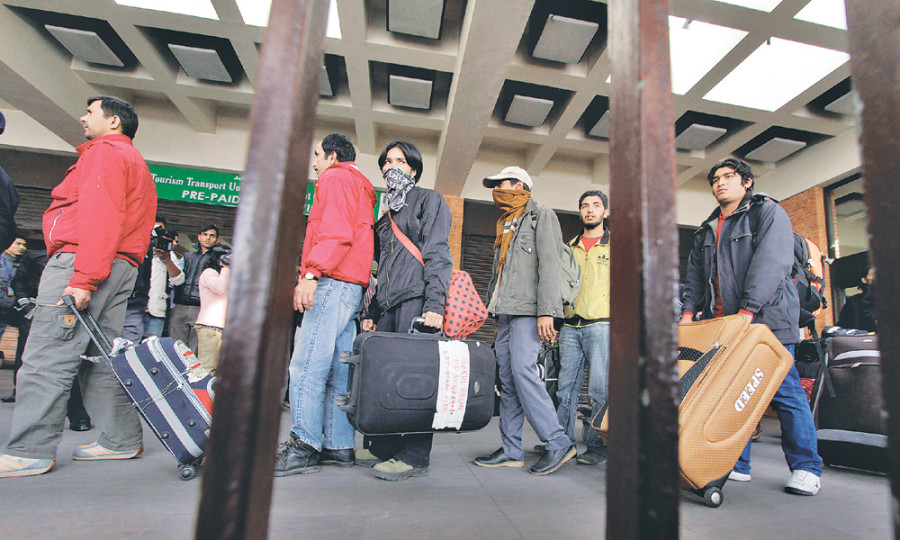Miscellaneous
The long way home
Fluctuating oil prices and the political instability in the Gulf has stakeholders debating the long-term feasibility of a remittance-driven economy
Roshan Sedhai
On May 1, the International Worker’s Day, Saudi Arabia remained embroiled in a labour strike, the likes of which the kingdom had seldom seen before. Employees with the Binladin Group were protesting the lay-off of at least 50,000 migrant labourers, allegedly without pay. In the riot that ensued, nine of the company’s buses were torched—sending shockwaves through a country where unions, collective bargaining, and strikes are banned.
An economy in tailspin
Until recently, the Binladin Group—a construction consortium founded in 1931 by Osama Bin Laden’s father—was one of Saudi Arabia’s largest employers, boasting a total workforce of 200,000 employees. A majority of their employees are migrant labourers from South and East Asia. Earlier this year, the company announced that it would be slashing 25 percent of its workforce. As many as 70,000 workers are believed to have already lost their jobs; and with the kingdom struggling to arrest its alarming economic decline, more look bound to follow.
Saudi Arabia’s oil-driven economy has been on a dangerous tailspin for over a year. An article in the Economic Monitor notes that oil revenue paid for 73 percent of the government’s budget in 2015. But crude oil, which was sold at USD 100 a barrel in 2014, had dramatically fallen to just USD 26 per barrel by February 2016. The prices have since bounced back to hover at about USD 50 per barrel, but that still is half of what it was fetching two years ago.
Saudi Arabia over the past decades has also pumped significant amount of its oil revenues in to holding a turbulent Middle-East—including itself—together. The Sunni kingdom has the world’s third largest defence budget—trailing only the US and China, and ahead of Russia—and provides financial backing to a host of countries including Egypt, Morocco and Jordan. Now with the country embroiled in a multiple-pronged war with the Islamic State in Syria and Iraq and the Houthi rebels in Yemen, Saudi Arabia’s already depleting revenues are running scarce. The downturn has hit the government—which employs almost 90 percent of its citizens—hard. The Saudi government, Forbes noted in a report, heavily subsidises commodities like food and oil, providing free healthcare, education, subsidised water and electricity, paid for public pensions and no income tax to its citizens. Now, with the debt to GDP ratio rising to 16 percent in 2015 (compared to 3.5 percent in 2014) the government has had little choice but to announce austerity measures against its bloated public spending.
It is the country’s estimated nine million migrant workers, however, that are bearing the brunt of the country’s economic nose-dive.
Paradise lost
There are an estimated 600,000 Nepalis currently working in Saudi Arabia. In June, when workers set fire to several vehicles of the Saudi Oger Company, accusing the company of non-payment of six month’s salary, the company retaliated by sacking hundreds of migrant workers, including 41 Nepalis. Elsewhere in the country, there have been hundreds of smaller companies that have shut down altogether.
In the wake of the massive lay-offs, the countries that provide the migrant workforce, like India, Bangladesh and Pakistan, are reportedly witnessing huge surge in the inflow of their citizens retuning from Saudi Arabia. Nepal’s mission in Riyadh, however, has said that the recent layoffs have had relatively less impact on Nepali workers. So far, around 500 Nepali workers have sought the embassy’s help—mostly with complaints of non-payment of wages. “It might be too early to say much but very few Nepali workers have approached the embassy seeking help. We have given clear instruction to the embassy to do the needful to help the workers who have lost their jobs,” said the spokesperson of the Ministry of Labour and Employment Govinda Mani Bhurtel.
In a recent statement, the Riyadh Embassy has clarified that it has not received reports of large-scale lay-offs involving Nepali migrant workers. “The embassy is working to relocate or facilitate the return of 41 Nepalis working in the Saudi Oger Company and looking into complaints received from other workers,” read the statement. According to the embassy, the Saudi government is positive about finding new placement for workers seeking to continue to work in Saudi Arabia. Others are to be sent home after they have been paid their outstanding dues.
Gordian’s knot
Despite the call for calm, stakeholders warn that the fluctuating oil prices and simmering tensions in the region might blowback into a bigger crisis in not just Saudi Arabia, but across the Persian Gulf.
With that in mind, recruiting agencies in Nepal have been following the developments closely. Saudi Arabia was the largest recipient of Nepali labourers in the fiscal year 2015-16. The country hired a total of 138,529 Nepalis in the past year alone. Recruiting agencies speculate that there will be a gradual demand for labour in the country, but as of now, more than 200,000 job vacancies posted by the country (including 176,659 posted in 2015) are yet to be filled.
“We are expecting a gradual decline in the job demand, especially in the construction sector. It’s not just the falling oil prices but the conflict simmering in the region that is likely to have an even bigger impact on the demand for labour,” says Bal Bahadur Tamang, former chairman of the Nepal Association of Foreign Employment Agencies.
Some stakeholders have been lobbying with the government to restrict work approvals for Nepalis seeking employment in small Saudi companies, or those red-flagged for their finances. They argue that such measures would go a long way in preventing future crises.
The government, however, has no immediate plans for the cancellation of the demand letters of the smaller companies. “It’s normal to have complaints from few a hundred workers in a country where around 600,000 are working. We may have to rethink if things turn for the worse but we cannot stop sending workers just because foreign workers have lost the jobs,” says spokesperson Bhurtel.
Ganesh Gurung, a foreign employment expert, paints a grimmer picture. “In the worst case scenario, we might have to pull back around two million Nepali workers from the Gulf.
The government must remain vigilant and be prepared for everything.”
Gurung believes that the government should begin formulating a well-laid out action plan by finding alternative destinations for workers or by “absorbing migrant populations” and “harnessing their skills and experiences” to develop sectors like agriculture, tourism and infrastructure development at home.
As a warning on failing to do so, Gurung says, “If the current Saudi crisis has taught us one thing, it is that the ‘oil bubble’ will not last forever. Countries like India and the Philippines are already drawing out contingencies for worst case scenarios. Nepali migrants too will return sooner or later. With that in mind, it is up to us to decide whether we act with foresight or the usual myopia.”




 13.12°C Kathmandu
13.12°C Kathmandu










